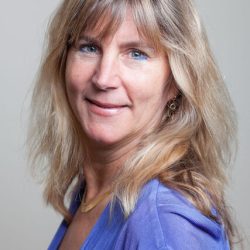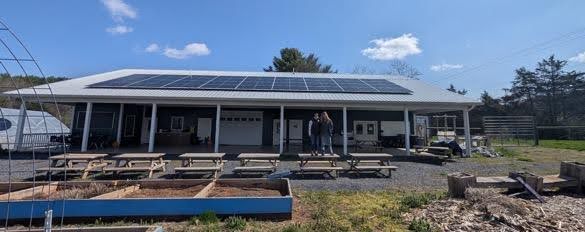
Solar Investing – Making a Concrete Difference
- Posted on
- By Ruth Amundsen
- In Blog, VA
A blog by Ruth Amundsen, CCAN supporter from Hampton Roads
In these days of political maelstrom and uncertainty, I love doing something that makes a concrete difference for our climate. Climate change is an imminent and serious threat to human society, both in our country and on our planet. I invest in solar because it is something I can do that creates more clean energy in the world and makes a tangible difference in people’s lives.
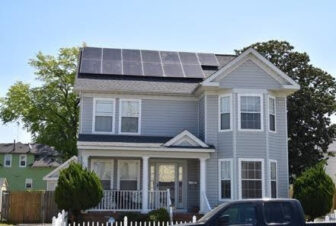
My solar investing is done through Power Purchase Agreements (PPAs), a way of putting solar on sites without the site paying upfront costs. I purchase the solar panels and take the tax credits, while the solar site benefits from lower utility bills and repays me from the savings generated by solar. After a term of 7-11 years, I am repaid for the solar investment, and ownership transfers to the site, which then enjoys all the savings going forward.
I finance solar in Virginia on homes, small businesses, and non-profits like churches and schools. It is incredibly heart-warming and impactful to stand on a roof with solar because you helped that homeowner or business install it. There is an immense pleasure in direct investment in installing solar that I have never felt with charitable donations to green funds, though I continue to support those as well.
Since starting this journey in 2018 in Hampton Roads, where I live, I have 14 active solar sites, including the first home in Virginia ever financed with a PPA!
From Hampton Roads to Charlottesville: The Community Benefits of Solar Energy for Churches, Schools, and Businesses
Recently, I have expanded to the Charlottesville region. Tiger Solar has been an amazing ally in finding unique and socially or environmentally beneficial sites. I currently have seven contracted sites in progress in the Charlotteville region, and I have never met any of the customers there. So I decided to take a trip out to Charlottesville to meet all my new solar installs. It was a fascinating and heart-warming trip!
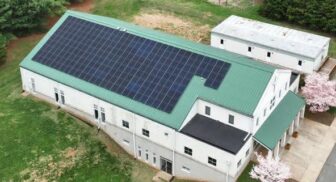
I visited two churches with solar, Christ Community Church and Church of Our Saviour, both warm and inclusive, with wonderful community programs. Even on a weekday, the Christ Community Church was busy and bustling with people from the area.
I was proud to see the solar on their roof, knowing it would save them money on their utility bill by providing over 80% of their annual electricity consumption, as well as making the air in Charlottesville a little cleaner by reducing the need for fossil-fuel-generated electricity. Church of Our Saviour will be putting solar on their Mission Building, which provides many supportive services for the community, and the solar will cover nearly 100% of that building’s energy needs.
I also gave a seminar to 8th graders at Peabody School, an environmentally conscious school that already has solar on three of its four buildings. The solar for the fourth building will be installed at the end of this school year. The students are bright, interactive, and motivated to do something about climate change.
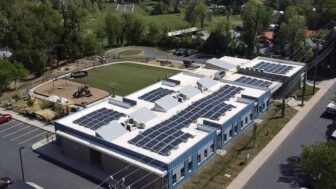
I visited the International School of Charlottesville, a language immersion school, with its large flat roof, which will cover 100% of its electricity needs with solar panels. They are excited to have solar panels on their roof and be able to show that energy production to the students.
Other impactful sites include Project Grows, a local organic farm using regenerative practices to produce over 200,000 servings of nutrient-dense food annually for markets, schools, and food pantries. They strive to be an example of more sustainable farming methods and will now also be an example of sustainable energy production.
I also travelled to Aquaphalt, a family-owned business manufacturing environmentally-friendly road repair material, a greener way to do patching of roads and potholes, using water and rapeseed oil, without the toxic petroleum-based solvents. Their flat roof is ideal for solar panels, allowing them to generate over 95% of their energy from solar power.
Another family-owned business I loved seeing was King Family Winery, a winery with gorgeous grounds, a wedding venue, and polo in the summer. They now have solar to cover nearly all of the electrical energy needs of their large wine-making operation.
Policy Challenges and Opportunities: Navigating Virginia’s Solar Landscape
This trip to the Charlottesville region was a great honor, meeting so many worthy organizations and helping them install solar. Solar installers value investors who fund small- to mid-size commercial projects, as these are often unattractive to large national financiers. However, while there was hope that Virginia would make it easier to install solar and use PPAs through new laws in 2025, one important bill, HB 1883, was vetoed by our Governor.
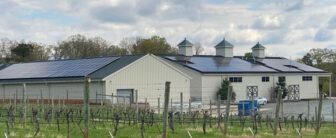
HB 1883 would have removed an outdated rule that required solar projects to be at least 50 kilowatts in size to qualify for PPA programs, except non-profit buildings and low-income homes.
This change would allow much smaller solar projects to participate in PPAs, making it easier for homeowners, small businesses, and community projects to install solar without upfront costs. HB 1883 would have increased the maximum size of solar projects eligible from 1 megawatt to 3 megawatts, enabling larger rooftop and small commercial solar systems to use PPAs.
Installing solar panels on homes, businesses, churches, and schools makes our energy mix cleaner, reduces air pollution and carbon footprint, and lowers utility bills. As we use more small to mid-size scale solar, it eases the transmission grid load since buildings generate their peak energy. It also shields us from utility rate increases and cuts costs for everyone as utilities avoid using expensive peaker plants, such as the $4.5 billion Chesterfield power plant.
Despite some setbacks, there is growing momentum for small- to mid-size solar in Virginia. I’m proud to be part of this clean energy movement, helping communities save money and protect our environment. I would love to have companions in my quest for more solar, so please reach out if this kind of investing appeals to you.
A blog by Ruth Amundsen, CCAN supporter from Hampton Roads
About the author: Ruth received her bachelor’s in physics from Stanford, and has dual engineering masters degrees from University of Michigan. She led a group of parents in installing 700 kW of solar on their children’s school.
She runs several LLCs for financing and installing solar on businesses and non-profits in low-income neighborhoods at no cost to the owners. These funds also trained and employed residents of those neighborhoods on the installation jobs.
She is on the boards of Virginia Distributed Solar Alliance, Solar United Neighbors and Solar Village Project, and on the advisory board for GiveSolar.
